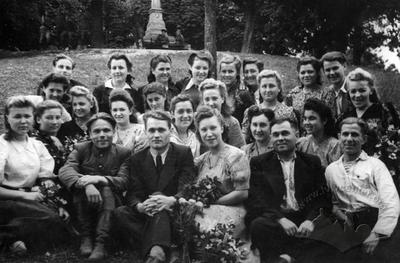Vul. Zolota – monument to Teofil Wisniowski and Josef Kapuscinski ID: 110
A marble obelisk under a project designed by Julian Markowski was set up in 1895 to commemorate Teofil Wisńiowski and Józef Kapusciński, participants of the November uprising of 1830-1831 in the Russian-administered Kingdom of Poland, as well as of movements directed against the Austrian Empire, who were executed there in 1847.
Story
The hill at the intersection of Kleparowska (Kleparivska) and Złota (Zolota) streets was a place of execution for two centuries. Hence, its traditional name was the Stracenia (Execution) Hill (also known as Hyclowska, since the city knacker's house was situated not far from there).
On 31 July 1847 Teofil Wiśniowski and Josef Kapuściński were hanged there. In July 1895, on the initiative of the then vice-president of the city, Michał Michalski, a marble obelisk on a pedestal of large stone blocks was placed on the hill; it had the following inscription: "To Teofil Wiśniowski, executed for freedom of the fatherland on 31 July 1847. Lviv citizens, 1895." Above the inscription a cross and a five-pointed star were carved; the obelisk was crowned with an eagle sculpture. The author of the monument was Julian Markowski, a famous Lviv sculptor. After the monument installation, a park was arranged on the hill under a project of Arnold Röhring, later known as the Wiśniowskiego Park.
For a long time, the memorial was in a neglected condition. In 2015 it was restored with the participation of Poland's Cultural Heritage Foundation. New memorial tables, a medallion, and eagles were made after the pattern of the lost ones. The funds for these works were provided by the Foundation of the Council for the Protection of Struggle and Martyrdom Sites (pol. Fundacja Rady Ochrony Pamięci Walk i Męczeństwa), the restoration works were carried out by a group of Poles and Ukrainians: Anna Sztymelska-Karczewska (leader), Piotr Maślanka, and Orest Dzyndra.
Related buildings and spaces
People
Teofil Wiktor Mikołaj
Wiśniowski, count Prus I (1806-1847) — a Polish revolutionary
who fought against the Russian and Austrian Empires.
Józef Kapuściński (1818-1847) — a Polish revolutionary who struggled against the Russian
and Austrian Empires.
Julian Markowski (1846-1903) — a famous Lviv sculptor, the author of the memorial.
Michał Michalski (1846-1907) — a blacksmith master, a member of the City Council of Lviv
from 1880, who initiated the establishment of a memorial to the rebels, then
(1895) the vice-president of Lviv.
Arnold Röhring — the then city gardener, the author of the project of the Wiśniowskiego Park (1897).












